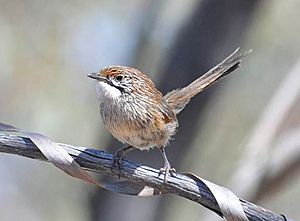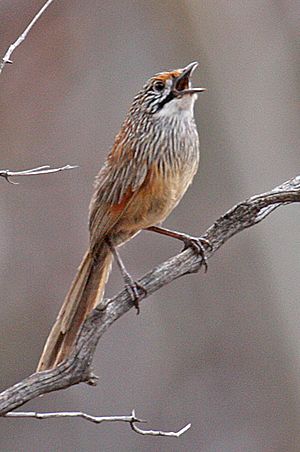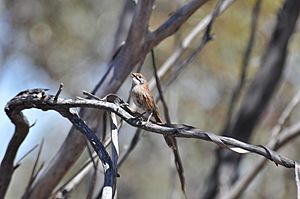Striated grasswren facts for kids
Quick facts for kids Striated grasswren |
|
|---|---|
 |
|
| Scotia Station, New South Wales. Source: Dan Eyles. | |
| Conservation status | |
| Scientific classification | |
| Genus: |
Amytornis
|
| Species: |
striatus
|
| Subspecies | |
|
See text |
|
The striated grasswren (Amytornis striatus) is a small, shy bird that lives on the ground. It is a type of wren and is found only in Australia. These birds live in dry and semi-dry areas across western, central, and southern Australia. They are often found where a special type of spiky grass called spinifex (Triodia) grows.
Contents
About the Striated Grasswren
What Does a Striated Grasswren Look Like?
The striated grasswren is one of 11 types of grasswrens. All grasswrens are small, secretive birds with long tails that often stick up. They have a thin, pointed beak. Their feathers can look different depending on where they live, matching the color of the local soil and rocks.
Female grasswrens have a brighter reddish patch on their sides. Both males and females are reddish-brown on top with white streaks. They have an orange-yellow stripe above their eye, a white throat, and a bold black stripe below their beak. Their belly is a buff (pale yellowish-brown) color.
How Do They Move?
Like other grasswrens, they have short, rounded wings. This means they can't fly long distances. They usually flutter or hop short distances between plants. When they are on the ground, they run or hop very quickly in jerky movements.
Striated grasswrens are bigger than the well-known fairy-wrens. They are also less brightly colored, with white streaks on different shades of brown, red, and black feathers.
How Do They Behave?
You usually see striated grasswrens in pairs, but sometimes alone or in small groups of up to five birds. They are very shy and hard to spot. Often, you will hear their calls before you see them. When they are nesting, they might become curious if someone comes into their area.
Life in the Wild
Where Do Striated Grasswrens Live?
Striated grasswrens are the most common type of grasswren. They live across northern South Australia, central and southwestern New South Wales, and into southern and eastern South Australia.
These birds love areas with sand, dunes, and rocky hills. They especially like places with lots of spinifex grass. Spinifex is very important for them. It provides food, safe places to nest, and cover from predators. They prefer areas where the spinifex has grown for 25–40 years after a fire. However, they can also live in areas that burned 6 to 8 years ago.
Daily Activities
Striated grasswrens can be active all day. If it's very hot (over 35°C), they might hold their wings partly open to cool down. They are usually most active in the early morning and late afternoon.
They mostly look for food on the ground. They search through fallen leaves under shrubs and around spinifex clumps. They always stay close to cover. When they are looking for food, they hop with their tail held almost straight up. If they are moving through thick bushes, their tail is held flat. If they are scared in an open area, they move very fast from one hiding spot to another. It looks like a bouncing ball!
What Do Striated Grasswrens Eat?
Striated grasswrens eat both insects and seeds. They find food on the ground among leaves and in open areas. They also pick insects from the leaves of small plants and shrubs. Their main diet includes beetles, ants, and seeds from spinifex and other plants.
They are sometimes seen foraging with other birds. These include the rufous-crowned emu-wren, willie wagtail, and variegated fairy-wren.
Reproduction and Family Life
Striated grasswrens are most often seen in pairs. Sometimes they are in groups of 3 to 10 birds. It's thought that family groups might be more common outside of the breeding season. These groups may travel over larger areas of their habitat.
In captivity, family members have been seen grooming each other and sunbathing together. They also bathe in dry soil and fine water mist. They sometimes chase each other around playfully.
Breeding usually happens between July and November. However, if there is enough rain, especially in central and northern Australia, they might breed at other times of the year.
The nest is a large, dome-shaped structure. It's made of spinifex spines and lined with bark, grass, plant fluff, and feathers. The nest is built close to the ground and is very well hidden, usually inside a spinifex clump.
The eggs are round-oval, white to pinkish-white, and have small purplish-red spots. A female usually lays 2 eggs, but sometimes 3. She sits on the eggs for 13–14 days. Once the chicks hatch, both parents help feed them and keep the nest clean. The chicks leave the nest after 12–14 days. They stay hidden in thick cover near the nest for a few more days. They become fully independent after about 3 to 4 more weeks.
Sometimes, other birds lay their eggs in a striated grasswren's nest. These "brood parasites" include the Horsfield's bronze cuckoo, black-eared cuckoo, and fan-tailed cuckoo.
What Sounds Do They Make?
Striated grasswrens have three main calls: a contact call, a song, and an alarm call. Their contact call is a soft, high-pitched seep, see-see, or tseee-tseet. It can be hard to hear if it's windy.
Their song is much louder and can be heard up to 40 meters away. It's a sweet, rippling sound, like a wren's song. It can last up to 10 seconds and includes whistles, buzzes, twangs, and short, sharp notes. They sing this song less often, sometimes from an open branch with their beak pointing up.
The alarm call is a series of short, loud, harsh notes, like jit-jit or tchiritt. They make this sound when they are scared out of their hiding spot.
Naming and History
How the Striated Grasswren Got Its Name
The striated grasswren (Amytornis striatus) belongs to the Maluridae family, which also includes the fairy-wrens. It is one of 13 types of grasswrens found only in mainland Australia.
The first person to describe this bird was John Gould in 1840. He found a specimen (a collected bird) on the Liverpool Plains in New South Wales.
The scientific name Amytornis comes from Greek. Amytis was an ancient Persian female name, and ornis means 'bird'. The second part of the name, striatus, means 'striped' or 'streaked' in Latin. This refers to the strong streaks on the bird's upper body.
Protecting the Striated Grasswren
Why Are They in Danger?
Some populations of striated grasswrens have been lost because large areas of land were cleared for farming. This also broke up their habitat into smaller pieces. Smaller groups of birds are more at risk from genetic problems and events like fires and droughts.
Large wildfires are a big threat. These birds don't fly well, so many can die in fires. Fires also destroy their habitat and remove their hiding places from predators. As mentioned, they prefer areas where spinifex has grown for 25–40 years after a fire.
Animals like goats and other livestock that were brought to Australia also cause problems. They eat the plants the grasswrens need, which changes their habitat. Predators like introduced foxes and cats also hunt grasswrens, especially when their populations are already small or their habitat is exposed after fires or land clearing.
What is Being Done to Help?
To help these birds, it's important to manage fires. Controlled burning can reduce the risk of large wildfires that destroy huge areas of habitat. It's also important to avoid fires caused by people.
Reducing the number of introduced grazing animals, especially goats, and keeping them out of some areas, helps the plants grow back. Controlling pests like cats, foxes, and rabbits also helps by reducing predation and competition for food.
The striated grasswren is listed as "near threatened" in Australia. It is also listed as "vulnerable" in New South Wales and South Australia.
See also
 In Spanish: Maluro estriado para niños
In Spanish: Maluro estriado para niños




